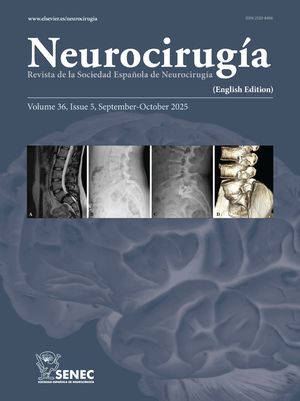Establecer las variables mínimas para diagnosticar las lesiones de la bóveda craneal con tomografía computarizada (TC) y comprobar la precisión de la regresión logística (RL) y las redes neuronales artificiales (RN) en su diagnóstico.
Material y MétodosEstudiamos 167 pacientes con lesiones de bóveda craneal como única manifestación conocida de enfermedad. Los datos clínicos y de la TC se emplearon para los modelos de RL y RN, que se probaron con el método jacknife. Los resultados finales de cada modelo se compararon con el área bajo la curva ROC (A2).
ResultadosLas lesiones fueron en un 73,1 % benignas y 26,9% malignas. No hubo diferencia estadísticamente significativa entre la RL y la RN para diagnosticar las lesiones malignas. Para la caracterización de los diagnósticos histológicos, la RN fue estadísticamente superior a la RL. Las variables necesarias para el diagnóstico de lesión maligna fueron la edad y la definición de los bordes, y para los diagnósticos histológicos, matriz, esclerosis marginal y la edad.
ConclusionesSe necesitan cuatro mínimas variables para el diagnóstico de estas lesiones, no siendo importante el tipo de sintomatología. Las redes neuronales ofrecen grandes posibilidades sobre la estadística para las lesiones de la bóveda craneal además de un mejor rendimiento diagnóstico.
To establish the minimun set of features needed in the diagnosis of calvarial lesions using computed tomography (CT) and to assess the accuracy of logistic regression (LR) and artificial neural networks (NN) for their diagnosis.
Material and Methods167 patients with calvarial lesions as the only known disease were enrolled The clinical and CT data were used for LR and NN models. Both models were tested with the jacknife method. The final results of each model were compared using the área under ROC curves (A2)
ResultsThe lesions were 73.1 % benign and 26.9% malignant. There was no statistically significant difference between LR and NN in differentiating malignancy. In characterizing the histologic diagnoses, NN was statistically superior to LR. Important NN features needed for malignancy classification were age and edge definition, and for the histologic diagnoses matrix, marginal sclerosis and age.
ConclusionsA mínimum four fetaures is needed to diagnose these lesions, not being important patients’ symptoms. NNs offer wide possibilities over statistics for the calvarial lesions study besides a superior diagnostic performance.
Article

If it is the first time you have accessed you can obtain your credentials by contacting Elsevier Spain in suscripciones@elsevier.com or by calling our Customer Service at902 88 87 40 if you are calling from Spain or at +34 932 418 800 (from 9 to 18h., GMT + 1) if you are calling outside of Spain.
If you already have your login data, please click here .
If you have forgotten your password you can you can recover it by clicking here and selecting the option ¿I have forgotten my password¿.






